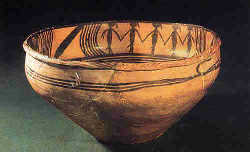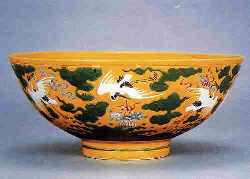 |
| Five-color Porcelain |
Chinese primitive tribes began making artifacts with clay as early as 8,000 years ago. The Yangshao Culture was noted for its distinctive pottery painted with flowers, fish, animals, human faces and geometric designs. Although the origin of porcelain techniques is unknown, it is believed that primitive porcelain ware emerged in the middle and lower reaches of the Yangtze River and the Yellow River during the Shang and Zhou dynasties (16thcentury � 221BC). Real porcelain ware appeared during the Han Dynasty (206BC - AD220).
|
|
| Celadon or qingci |
The ceramic industry of the Song Dynasty (960-1279), the third most prosperous period of the Chinese feudal society, reached an unprecedented height. Porcelain kilns with vivid regional features had spread all over the country, forming the “six kiln factions” and “five famous kilns”. The “six kiln factions” were thedingkiln faction,junkiln faction,yaozhoukiln faction,cizhoukiln faction,longquankiln faction andjingdezhenkiln faction. The “five famous kilns” were theguankiln,rukiln,gekiln,dingkiln andjunkiln.
The Yuan Dynasty (1271-1368) saw a continued rapid development of the ceramic industry. Blue and white porcelain, which emerged in the Tang and Song dynasties, reached its maturity. The porcelain capital Jingdezhen emerged, which was famous for its blue-and-white porcelain, red under-glazed porcelain and egg-white porcelain. Great achievements were made in the production of the colorant glaze. Prior to the Yuan Dynasty people had fewer color choices.
|
|
| Tri-color Tang Pottery |
The early Qing Dynasty (1644-1911) witnessed the peak of Chinese ceramic production, with all ceramic types radiating their influence worldwide.
In the process of ceramic development, different styles of different periods blossomed over the centuries.
|
|
| Blue-and-white Porcelain |
Tri-color Tang Pottery, or T ang Sancai, of the Tang Dynasty was named after the bright yellow, green and white glazes that were applied to the earthenware body. They not only appeared in such traditional forms as bowls and vases, but also in the more exotic guises of camels and Central Asian travelers, testifying to the cultural influence of the Silk Road.
Blue-and-white Porcelain, first produced in the Yuan Dynasty, was baked at an extremely high temperature and characterized by the purity of its kaolin clay body. It reached its golden era in the Ming Dynasty, coming to represent the virtuosity of the Chinese potter.
 |
| Five-color Porcelain |
Chinese ceramic art has long played an important role in foreign exchange. Pottery and porcelain have been exported from early periods. During the Song Dynasty, large quantities of porcelain were exported via the Silk Road.
After the birth of New China in 1949, social stability led to the revival of the ceramic industry, regaining its previous glory and greater recognition both home and abroad.













